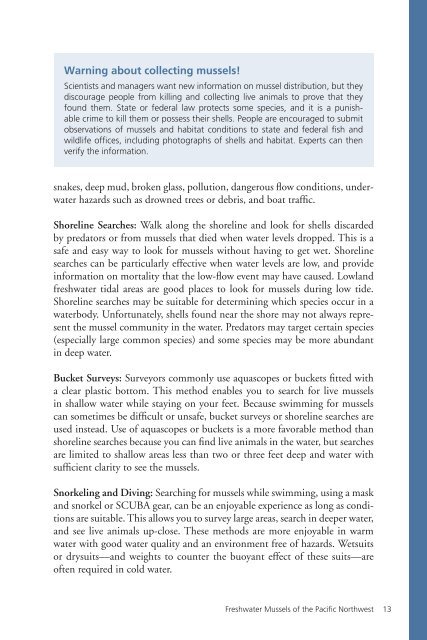Freshwater Mussels Pacific Northwest - The Xerces Society
Freshwater Mussels Pacific Northwest - The Xerces Society
Freshwater Mussels Pacific Northwest - The Xerces Society
Create successful ePaper yourself
Turn your PDF publications into a flip-book with our unique Google optimized e-Paper software.
Warning about collecting mussels!<br />
Scientists and managers want new information on mussel distribution, but they<br />
discourage people from killing and collecting live animals to prove that they<br />
found them. State or federal law protects some species, and it is a punishable<br />
crime to kill them or possess their shells. People are encouraged to submit<br />
observations of mussels and habitat conditions to state and federal fish and<br />
wildlife offices, including photographs of shells and habitat. Experts can then<br />
verify the information.<br />
snakes, deep mud, broken glass, pollution, dangerous flow conditions, underwater<br />
hazards such as drowned trees or debris, and boat traffic.<br />
Shoreline Searches: Walk along the shoreline and look for shells discarded<br />
by predators or from mussels that died when water levels dropped. This is a<br />
safe and easy way to look for mussels without having to get wet. Shoreline<br />
searches can be particularly effective when water levels are low, and provide<br />
information on mortality that the low-flow event may have caused. Lowland<br />
freshwater tidal areas are good places to look for mussels during low tide.<br />
Shoreline searches may be suitable for determining which species occur in a<br />
waterbody. Unfortunately, shells found near the shore may not always represent<br />
the mussel community in the water. Predators may target certain species<br />
(especially large common species) and some species may be more abundant<br />
in deep water.<br />
Bucket Surveys: Surveyors commonly use aquascopes or buckets fitted with<br />
a clear plastic bottom. This method enables you to search for live mussels<br />
in shallow water while staying on your feet. Because swimming for mussels<br />
can sometimes be difficult or unsafe, bucket surveys or shoreline searches are<br />
used instead. Use of aquascopes or buckets is a more favorable method than<br />
shoreline searches because you can find live animals in the water, but searches<br />
are limited to shallow areas less than two or three feet deep and water with<br />
sufficient clarity to see the mussels.<br />
Snorkeling and Diving: Searching for mussels while swimming, using a mask<br />
and snorkel or SCUBA gear, can be an enjoyable experience as long as conditions<br />
are suitable. This allows you to survey large areas, search in deeper water,<br />
and see live animals up-close. <strong>The</strong>se methods are more enjoyable in warm<br />
water with good water quality and an environment free of hazards. Wetsuits<br />
or drysuits—and weights to counter the buoyant effect of these suits—are<br />
often required in cold water.<br />
<strong>Freshwater</strong> <strong>Mussels</strong> of the <strong>Pacific</strong> <strong>Northwest</strong> 13

















